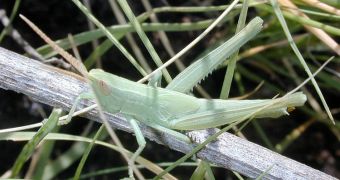In a study conducted on a species of grasshopper called the Desert Locust, researchers finally managed to identify what makes the creatures move from a solitary, secluded phase to a gregarious one. Apparently, it all comes down to the actions of a single molecule.
The research team explains that the molecule they identified has been associated with learning and memory. Even though it may seem beneficial at first, it is in fact the main reason why grasshoppers move from being harmless insects to pests in a matter of days.
In the specific case of Desert Locusts, the situation is a bit weird, to say the least. They survive in an extremely harsh environment, and they adapted to their surroundings perfectly. In their solitary phase, each of the insects purposefully and carefully avoids the other.
This type of behavior lasts throughout the dry season, when only a few of them are available. When the rain comes, their numbers increase significantly, as food begins to abound. But the rains eventually end, and the landscape begins to decay again.
When this happens, the insects are driven onto the few patches of land where survival is still possible. This is where the previously-mysterious change occurred – the insects actively began to seek out each other's company, and formed swarms that then swept over the landscape.
In the new investigation, University of Cambridge investigators figure out that the specific signaling protein in the locusts' brains was responsible for triggering the social change from their solitary to their gregarious phase.
Known as protein kinase A, the molecule only performs this task when the time is right, and not during other periods of the year. The research effort was led by Cambridge investigator Dr. Swidbert Ott.
In collaboration with colleagues at the University of Leuven, the team was able to conclude that the actions of this particular molecules elicit the same response in locusts as social changes do in humans.
“Learning is when you change your behavior in the light of new experience, and this is what a locust needs to do when it gets caught up in the crowd. What is amazing is that the parallels don’t just end there, they extend to the specific proteins that bring about the behavioral changes,” Ott concludes.
Details of the study appear in this week's issue of the esteemed journal Proceedings of the National Academy of Science (PNAS).

 14 DAY TRIAL //
14 DAY TRIAL //